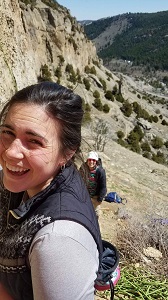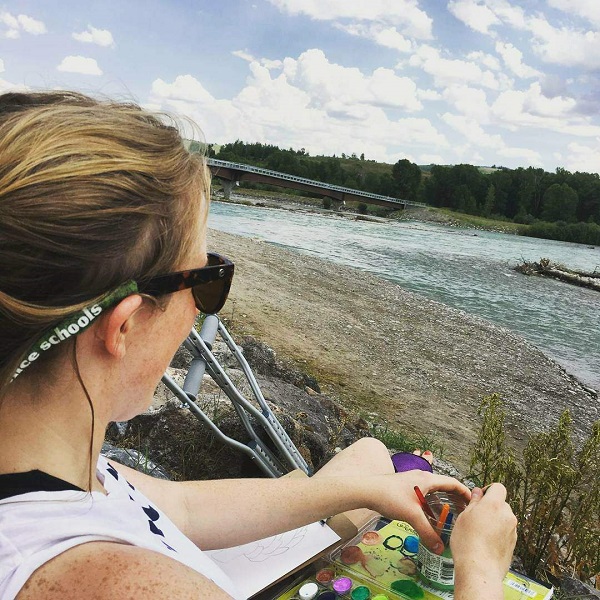
After moving to Jackson in the middle of mud-season, the prospect of my first summer in the valley was an exciting one. I spent my rainy days after work reading guidebooks and creating a list of realistic goals for hiking and climbing in the summer. As each day passed, the excitement of the warm days spent in the alpine grew and became almost unbearable. Due to the excess of rainy days in Jackson, some girlfriends and I started chasing sunshine by heading southeast to Lander to camp and climb on the weekends. I was getting stronger, and my love of climbing continued to grow with each new route.
 And then things took a turn for the worse.
And then things took a turn for the worse.
One weekend, while climbing at the Wild Iris, I took a huge “whip,” a fall that brought me into contact with the rock wall itself. The first thing to hit was my foot, resulting in a shattered talus (the bone that allows for lateral motion in the ankle), a broken calcaneus, and a surgery date.
Living in a place like Jackson with an injury can be extremely frustrating, and, at times, isolating. While my friends were out conquering their summer goals list, backpacking in the Gros Ventre, climbing at Blacktail Butte, or doing alpine climbs in Grand Teton National Park, I was watching Meru on the couch. Being an active person, I could only watch so many movies about climbing before I realized I needed to figure out some activities for the long three months of recovery to come. Much to my own surprise, Jackson is full of things to do that do not involve strenuous outdoor activity or even the use of two legs.
 This summer, I was able to experience Jackson through a different lens than I originally anticipated. The arts, culture, and conservation ethic of this town definitely surprised me. On Monday nights, I would often attend the Hootenanny at Dornan’s. This event is a wonderful Jackson tradition started by Bill Briggs, a legend in the ski community known for being the first to descend the Grand Teton on skis. “The Hoot” is a weekly space for local artists to express themselves; local musicians from across the valley come together for an open-mic night in a beautiful performance space. On any given Monday you can find good food and drink, music worth dancing to, even with crutches, and a beautiful space to watch the sunset with friends. Not to mention, the event itself is free!
This summer, I was able to experience Jackson through a different lens than I originally anticipated. The arts, culture, and conservation ethic of this town definitely surprised me. On Monday nights, I would often attend the Hootenanny at Dornan’s. This event is a wonderful Jackson tradition started by Bill Briggs, a legend in the ski community known for being the first to descend the Grand Teton on skis. “The Hoot” is a weekly space for local artists to express themselves; local musicians from across the valley come together for an open-mic night in a beautiful performance space. On any given Monday you can find good food and drink, music worth dancing to, even with crutches, and a beautiful space to watch the sunset with friends. Not to mention, the event itself is free!
Along with experiencing local musicians, I decided to challenge myself by channeling my artistic side, so often neglected during peak hiking, climbing, and backpacking season. I took advantage of the Center for the Arts and participated in a four-week watercolor course. This introductory course was taught by a local artist who catered to the learning needs of each individual. We learned everything from complimentary colors, to how to do still life painting, to the difference between wet on wet watercoloring and wet on dry. While enrolled in the course, I also had access to a great studio space. The price of a class may seem daunting at first, but the Center and the Jackson Hole Art Association offer a variety of scholarships for classes and give members discounts. Taking this class allowed me to rediscover the benefit art has on the mind, and this newly practiced skill gave me a great outlet during my recovery process and a offered a unique excuse to get outside. After the class ended, I bought my own watercolor supplies and would spend one or two days a week painting outside next to the Snake, at String Lake, or even just in my backyard. And Jackson’s not just a place for solo artists; the town holds a wide variety of art events throughout the summer. My favorites were the monthly art walks in town, in which galleries would open their doors, serve wine and appetizers, and highlight artists’ work.
 In addition to the arts, Jackson is a hub for passionate people who value conservation and our public lands and fight hard to protect them. I attended a variety of different talks, documentaries, and events that all had ties to conservation. Most notably, I attended a few talks put on by the Jackson Hole Conservation Alliance during their summer speaker series. The Alliance’s mission is “Protecting the wildlife, wild places, and community character of Jackson Hole by empowering the whole community to live in balance with nature.” They emphasize the importance of getting involved on a local scale. Due to the talks I attended and things I learned from various speakers, I chose to get involved with a citizen science project helping input data on research being done on local wildflower populations. Along with the project, I applied to be a part of the Conservation Leadership Institute. This rigorous 12-week program organized by the Alliance will empower my cohort and me with the skills needed to take our passion and turn it into action. We will learn to “organize, advocate, and hold local decision-makers accountable for building a better future for Jackson Hole.”
In addition to the arts, Jackson is a hub for passionate people who value conservation and our public lands and fight hard to protect them. I attended a variety of different talks, documentaries, and events that all had ties to conservation. Most notably, I attended a few talks put on by the Jackson Hole Conservation Alliance during their summer speaker series. The Alliance’s mission is “Protecting the wildlife, wild places, and community character of Jackson Hole by empowering the whole community to live in balance with nature.” They emphasize the importance of getting involved on a local scale. Due to the talks I attended and things I learned from various speakers, I chose to get involved with a citizen science project helping input data on research being done on local wildflower populations. Along with the project, I applied to be a part of the Conservation Leadership Institute. This rigorous 12-week program organized by the Alliance will empower my cohort and me with the skills needed to take our passion and turn it into action. We will learn to “organize, advocate, and hold local decision-makers accountable for building a better future for Jackson Hole.”
Living in Jackson Hole, it is very easy to get swept up by the culture that revolves solely around recreating in the mountains. Often, when chatting with someone in Jackson, conversations begin with a rundown of miles hiked, biked, or run over the previous weekend, or tales of peaks conquered and new routes climbed. While getting outside and recreating is extremely valuable in teaching us a myriad of lessons, and connecting us with other like-minded individuals, I think it is important to remember the other parts of life that bring us joy and help us grow. There are so many ways to get involved in the community here, and many of them do not even require the use of hiking boots.
So, the next time you decide to skip out on a long hike, or are waiting for the mud to turn to snow, check out some local events and expand the depth of your connection to this place in a new way.


